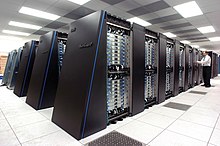
Back فورتران Arabic Fortran AST Fortran Azerbaijani Фортран Bashkir Fortran Byelorussian FORTRAN Bulgarian ফরট্রান Bengali/Bangla FORTRAN BS Fortran Catalan فۆرتران CKB
| Paradigm | Multi-paradigm: structured, imperative (procedural, object-oriented), generic, array |
|---|---|
| Designed by | John Backus |
| Developer | John Backus and IBM |
| First appeared | 1957 |
| Stable release | Fortran 2023 (ISO/IEC 1539:2023)
/ November 17, 2023 |
| Typing discipline | strong, static, manifest |
| Filename extensions | .f90, .f, .for |
| Website | fortran-lang |
| Major implementations | |
| Absoft, Cray, GFortran, G95, IBM XL Fortran, Intel, Hitachi, Lahey/Fujitsu, Numerical Algorithms Group, Open Watcom, PathScale, PGI, Silverfrost, Oracle Solaris Studio, others | |
| Influenced by | |
| Speedcoding | |
| Influenced | |
| ALGOL 58, BASIC, C, Chapel,[1] CMS-2, DOPE, Fortress, PL/I, PACT I, MUMPS, IDL, Ratfor | |
Fortran (/ˈfɔːrtræn/; formerly FORTRAN) is a third generation, compiled, imperative programming language that is especially suited to numeric computation and scientific computing.
Fortran was originally developed by IBM.[2] It first compiled correctly in 1958.[3] Fortran computer programs have been written to support scientific and engineering applications, such as numerical weather prediction, finite element analysis, computational fluid dynamics, geophysics, computational physics, crystallography and computational chemistry. It is a popular language for high-performance computing[4] and is used for programs that benchmark and rank the world's fastest supercomputers.[5][6]

Fortran has evolved through numerous versions and dialects. In 1966, the American National Standards Institute (ANSI) developed a standard for Fortran because new compilers would slightly change the syntax.[7] Nonetheless, successive versions have added support for strings (Fortran 77), structured programming, array programming, modular programming, generic programming (Fortran 90), parallel computing (Fortran 95), object-oriented programming (Fortran 2003), and concurrent programming (Fortran 2008).

Since August 2021, Fortran has ranked among the top fifteen languages in the TIOBE index, a measure of the popularity of programming languages.[8]
- ^ "Chapel spec (Acknowledgements)" (PDF). Cray Inc. October 1, 2015. Archived (PDF) from the original on February 5, 2016. Retrieved January 14, 2016.
- ^ John Backus. "The history of FORTRAN I, II and III" (PDF). Softwarepreservation.org. Archived (PDF) from the original on July 26, 2007. Retrieved November 19, 2014.
- ^ Wilson, Leslie B. (2001). Comparative Programming Languages, Third Edition. Addison-Wesley. p. 16. ISBN 0-201-71012-9.
The manual for Fortran I was released in 1956, but it was 1958 before successful compilers were running programs correctly.
- ^ Eugene Loh (June 18, 2010). "The Ideal HPC Programming Language". Queue. 8 (6).
- ^ "HPL – A Portable Implementation of the High-Performance Linpack Benchmark for Distributed-Memory Computers". Retrieved February 21, 2015.
- ^ "Q13. What are the benchmarks?". Overview – CPU 2017. SPEC. Retrieved November 13, 2019.
- ^ Wilson, Leslie B. (2001). Comparative Programming Languages, Third Edition. Addison-Wesley. p. 18. ISBN 0-201-71012-9.
Another problem was that there was no standard for Fortran and so slightly different versions ... would likely fail when used with a different compiler.
- ^ TIOBE Software BV (September 2022). "TIOBE Index". TIOBE.com. TIOBE. Retrieved September 23, 2022.
© MMXXIII Rich X Search. We shall prevail. All rights reserved. Rich X Search